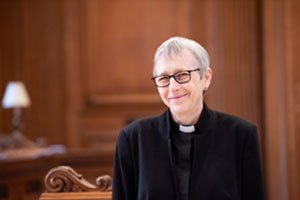We have just heard one of those Gospel readings that has left generations of preachers tying themselves in knots as they try to work out what on earth they can find to say about it, because at face value it is so disturbing. Did Jesus really behave so dismissively to a woman who was so obviously in need?
What is even more extraordinary is that the story we heard a moment ago, from St Matthew, is considerably less shocking than the original version, which we find in Mark, the earliest of the four Gospels. It would seem that even St Matthew struggled with the story and felt the need to tone it down.
So, if you are braced for a bit of a bumpy theological ride, let’s start by going right back to the earliest, no-holds-barred version of this story, as originally told by St Mark. And what he tells us is this:
Jesus is in a house in the city of Tyre. He is hoping that nobody will find him, and that everyone will just leave him alone for a while. Basically, Jesus needs a break. But of course, he couldn’t escape notice for long – and a Gentile woman turns up: a Syrophoenician, whose daughter has an unclean spirit. And the woman bows down at Jesus’s feet. and begs him to heal her daughter. His response to this unfortunate woman is not only abrupt – it is actually insulting: ‘Let the children be fed first, for it is not fair to take the children’s food and throw it to the dogs,’ he retorts.
Undeterred, the woman has the courage to challenge him: ‘Sir, even the dogs under the table eat the children’s crumbs.’ At which point Jesus responds: ‘For saying that, you may go – the demon has left your daughter. And the woman went home, and found her child lying in bed, the demon gone.
What is so challenging about this story, which has for centuries left Christians feeling deeply uncomfortable, is that it shows us a side of Jesus we would much rather not know about. There are, of course, other places in the Gospels where Jesus shows himself to be the master of the sharp retort; there is the cleansing of the Temple, too, when he overturned the tables of the money-changers, and drives them out with a whip made of cord. But mostly he does this kind of thing as a sort of Robin Hood figure – taking on religious corruption and fighting valiantly on the side of the vulnerable and defenceless against the religious authorities. And we can deal with that.
What is so disturbing about this story, is that Jesus is addressing a woman who has come to him in great distress and in abject need. She bows at Jesus’s feet. No wonder so many clergy over the years have tried to do their best either to sidestep this story completely, or to attempt to explain it away. The usual explanation (which is wholly unconvincing) is that Jesus was of course only pretending to be harsh in order to test the Syrophoenician woman’s faith – he didn’t really mean it.
But that kind of explanation simply will not do. It is nonsense and it does not ring true. Nor, incidentally, does it let Jesus off the hook. To one who is desperate, his retort is dismissive almost to the point of cruelty. No, it seems to me that there is something much more significant going on here, which is perhaps, in its own way, even more challenging.
Before I go on to explain what I mean by that, let’s have a quick look at the ways in which Matthew does his best to tone this story down in the version we heard this morning. First, he leaves out any reference to Jesus finding a house to hide in, and any suggestion that Jesus is desperate to escape. In Matthew’s version we are simply told that Jesus turned up in Tyre and Sidon. And when the woman appears, she approaches Jesus and his whole entourage and she does so shouting at him. This is no longer a private encounter between Jesus, and a woman who comes to him in quiet desperation. This is a public event.
Matthew tells us that, in response to the shouting woman Jesus in fact said nothing. Instead it is his disciples who want the woman turned away, as a result of her own bad behaviour: ‘Send her away for she keeps shouting after us.’ And when Jesus says ‘I was sent only to the lost sheep of the house of Israel’, he is speaking not to the woman, but to the disciples. In other words, Matthew changes the dynamic of the whole encounter. And as a result, the interaction between Jesus and the woman appears much gentler by comparison: she kneels before Jesus saying, ‘Lord, help me,’ and it is then that Jesus says those words about not giving children’s food to the dogs. But his response to her feels far less abrupt and dismissive – and Matthew has already led us to believe that it was the woman’s own pushy behaviour that was part of the problem in the first place.
I want us to return to the original, more challenging version, partly because I don’t want to duck its difficulties, but also because I think that it is in Mark’s Gospel that we perhaps find clues to what is really going on here.
In St Mark’s version, this story follows immediately after an incident in which Jesus has been condemned by the Scribes and the Pharisees for allowing his disciples to eat food with unwashed hands, thereby transgressing the Jewish law. Jesus in turn accuses them of hypocrisy, and quotes Isaiah against them, saying: ‘This people honours me with their lips, but their hearts are far from me; in vain do they worship me, teaching human precepts as doctrines.’
In other words, Jesus points out that what God asks of his people is ultimately a thing of the heart. The externals of religion, such as handwashing, and all the other distinctions between clean and unclean, are meaningless without that. By implication, of course, he is also calling into question one of the most basic distinctions between Jew and Gentile, because in daily life the Jewish purity laws enforced their separation from Gentiles.
It is immediately after this dispute with the religious authorities that Jesus finds himself confronted by the Syrophoenician woman in Tyre, who is a Gentile who has faith. She is a Gentile who has the law of God in her heart. In other words, she embodies the very thing that Jesus has just been talking about to the Scribes and Pharisees. Jesus has just made it clear that the distinction between clean and unclean is not what ultimately matters in the eyes of God. And here she is.
In that house in Tyre, Jesus is exhausted and drained, and doesn’t want to see anyone, least of all this wretched woman, who has no right to make demands of him. She is not even Jewish! But when she demonstrates a faith that is stronger than his rebuke to her, that is something he simply cannot ignore. Because in doing so she has also, quite without realising it, presented a challenge to him: how does what Jesus has just been saying, relate to what he is doing now?
Christian orthodoxy has always affirmed the full humanity, as well as the full divinity of Christ. But sometimes we really do struggle with the ‘full humanity’ bit. We can deal with those incidents when Jesus is shown weeping and exhausted, or angry; we can manage when we see him agonising over his destiny in the Garden of Gethsemane. We can even take account of his utter despair and desolation when, in agony, he cries from the cross: ‘My God, my God, why have you forsaken me?’
But we still find it hard to get to grips with the idea that Jesus didn’t appear on the earth fully formed as the Messiah, all-knowing and all-wise. And yet, the notion that Jesus was himself on a journey of self-discovery is entirely consistent with the story that St Mark recounts in his Gospel – indeed, if you read it carefully, it is perfectly plausible that it was only at his moment of baptism that Jesus’s self-awareness of his unique vocation truly began. But if we are to take the full humanity of Christ seriously, alongside his full divinity, there must have been some progression, because omniscience is not a human trait. Nor do we appear from the womb fully formed. That is why it is so wonderful that we have four Gospels: in Mark we see Jesus at his most human; in John we see him at his most divine. We need both.
But that is also why I find St Mark’s Gospel so utterly refreshing and real and encouraging. Because the Jesus we encounter there really is one of us, in his weakness, and exhaustion, and exasperated rattyness. It does not strike me as remotely problematic that his own understanding of the true nature of his calling, and the true cost of his calling, might have unfolded for him, as his ministry unfolded – and, just possibly, the Syrophoenician woman helped him to recognise one crucial part of it.
Because Jesus, the Christ, is not merely our saviour; he is also the one upon whose life we should strive to model our own. And far from detracting from my faith in him, the fact that we see Jesus as truly one of us makes his significance for our salvation far more real, and far, far more meaningful.



